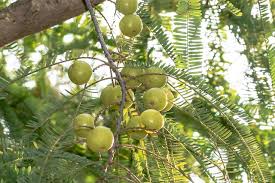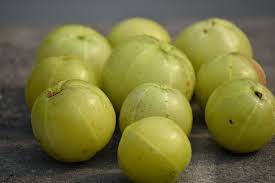
What happens if we eat amla daily?
Amla (Indian Gooseberry): Benefits, Risks, and Precautions
Amla, or Indian gooseberry, has been a staple in Ayurvedic medicine for centuries. Packed with essential nutrients like vitamin C, antioxidants, and minerals, this fruit offers numerous health benefits.
—
Health Benefits of Amla:
1. Boosts Immunity:
Amla is rich in vitamin C, which strengthens the immune system and helps protect the body against infections and diseases.
2.Improves Digestion:
The high fiber content in amla promotes healthy bowel movements and helps alleviate digestive issues like constipation, heartburn, and indigestion.
3.Promotes Heart Health:
Amla may help lower cholesterol levels, regulate blood pressure, and reduce the risk of heart disease.
4.Enhances Skin Health:
The antioxidants in amla protect the skin from damage caused by free radicals. Regular consumption may help reduce wrinkles, fine lines, and age spots.
5.Strengthens Hair:
Amla is known to fortify hair follicles, prevent hair loss, and improve hair texture and color.
6.Supports Eye Health:
With its vitamin A content, amla contributes to better vision and may help prevent age-related macular degeneration.
7.May Help Manage Diabetes:Amla may assist in regulating blood sugar levels and improving insulin sensitivity, which can be beneficial for individuals with diabetes.
—
Potential Risks and Side Effects:
1.Stomach Upset:
Consuming large amounts of amla may cause diarrhea, nausea, and vomiting.
2.Low Blood Sugar:
Amla can lower blood sugar levels, which may be risky for people taking diabetes medications.
3.Drug Interactions:
Amla may interact with certain medications, such as blood thinners and diabetes drugs.
4.Allergic Reactions:
Some individuals may experience allergic reactions to amla.
—
Precautions to Consider:
Consult your doctor before taking amla supplements, especially if you have pre-existing health conditions.
Start with small amounts and gradually increase your intake.
Monitor for any adverse effects.
Avoid consuming amla during pregnancy or breastfeeding unless advised by a healthcare provider.
Summary:
Amla is a nutrient-rich fruit with numerous potential health benefits. However, it’s essential to be mindful of possible side effects and interactions with medications. Always consult a healthcare professional before incorporating amla or its supplements into your routine.

What happens if we eat amla daily?
Amla Murabba Recipe
Ingredients:
1 kg Amla (Indian Gooseberry)
1 kg Sugar
4-5 Cloves (optional)
1 tsp Cardamom Powder
1 tsp Saffron Strands (optional)
1 tsp Lemon Juice
—
Instructions:
Step 1: Boil the Amla
2.Wash the amlas thoroughly to clean them.
3. In a large pan, boil 1 liter of water.
4. Add the amlas and cook for 10-12 minutes until they become soft.
4. Drain the water and allow the amlas to cool.
—
Step 2: Prepare the Sugar Syrup
- 1. In another pan, mix 1 kg sugar with 500 ml water.
- Boil the mixture until it reaches a slightly sticky consistency.
- Add 1 tsp lemon juice to prevent the sugar from crystallizing.
—
Step 3: Cook the Amla in Syrup
- Prick each boiled amla with a fork to help the syrup absorb better.
- 2. Add the pricked amlas to the sugar syrup.
- Cook on low heat for 20-25 minutes until the syrup thickens and the amlas turn translucent.
—
Step 4: Add Flavor
Add cardamom powder, cloves, and saffron strands for a rich flavor.
- Stir the mixture well and cook for another 5 minutes.
—
Step 5: Cool and Store
- Turn off the heat and let the amla murabba cool completely.
- Transfer the murabba into a clean, airtight jar for storage.
—
Enjoy your homemade Amla Murabba as a nutritious and delicious sweet treat!

What happens if we eat amla daily?
Amla Pickle Recipe (Indian Gooseberry Pickle)
Ingredients:
Ripe amla (Indian gooseberry)
Mustard or sesame oil
Salt
Red chili powder
Turmeric powder
Fenugreek seeds
Mustard seeds
Asafoetida (hing)
Cloves
Cinnamon
Dry ginger powder
Instructions:
1. Prepare the amla:
Wash the amla thoroughly and pat them dry. Cut them into small pieces or slices.
2. Heat the oil:
In a heavy-bottomed pan, heat mustard or sesame oil.
3.Temper the spices:
Add mustard seeds to the hot oil. Once they start spluttering, add asafoetida, cloves, and cinnamon.
4.Add the amla:
Add the sliced amla to the pan and stir well to coat them with oil.
5.Add dry spices:
Sprinkle red chili powder, turmeric powder, dry ginger powder, and salt over the amla. Mix everything well.
6.Cook and simmer:Cook the mixture on low heat for about 10-15 minutes, stirring occasionally, until the amla pieces soften and absorb the spices.
7.Add fenugreek seeds:
Add fenugreek seeds and cook for another 2-3 minutes.
8.Cool and store:
Let the pickle mixture cool completely. Transfer it to a clean, air-tight glass jar and seal it tightly.
Tips for a perfect pickle:
For more tanginess: Add a squeeze of lemon juice.
For a sweeter pickle: Add some jaggery or sugar.
To extend shelf life: Sterilize the jar before storing the pickle.
Best flavor: Let the pickle sit for at least a week before eating to enhance the taste.
Enjoy your homemade amla pickle! It pairs wonderfully with Indian meals, adding a burst of flavor and nutrition.
Note:
Be mindful of dietary restrictions and allergies.
For any health concerns, consult a healthcare professional before trying new recipes.
Amla and Belly Fat Reduction: Informational Guide
Disclaimer: This is for informational purposes only. For medical advice, diagnosis, or treatment, please consult a healthcare professional.
Amla, also known as Indian gooseberry, is a nutrient-rich fruit that may provide some indirect benefits in reducing belly fat when combined with a healthy lifestyle. Here’s how it can help:

What happens if we eat amla daily?
Potential Benefits of Amla for Belly Fat Reduction:
1. Boosts Metabolism:
Amla is a rich source of vitamin C, which can enhance your metabolism. A faster metabolism may help your body burn more calories, including those stored as belly fat.
2. Improves Digestion:
The fiber content in amla promotes better digestion and helps prevent constipation. A healthy digestive system plays a key role in effective nutrient absorption and weight management.
3. Reduces Inflammation:
Amla contains powerful antioxidants that may reduce inflammation in the body. Chronic inflammation is associated with increased fat storage, particularly around the belly.
4.Helps Control Blood Sugar:
Amla may aid in regulating blood sugar levels. Unstable blood sugar can contribute to weight gain and fat accumulation in the abdominal area.
Important Considerations:
Amla alone is not a magic solution for reducing belly fat.
Consistent physical activity and a balanced diet are essential for long-term fat reduction.
For personalized advice, consult a healthcare provider or a registered dietitian.